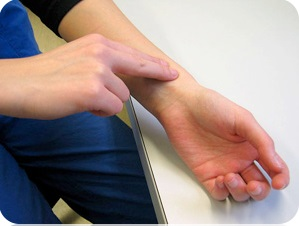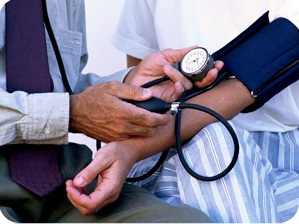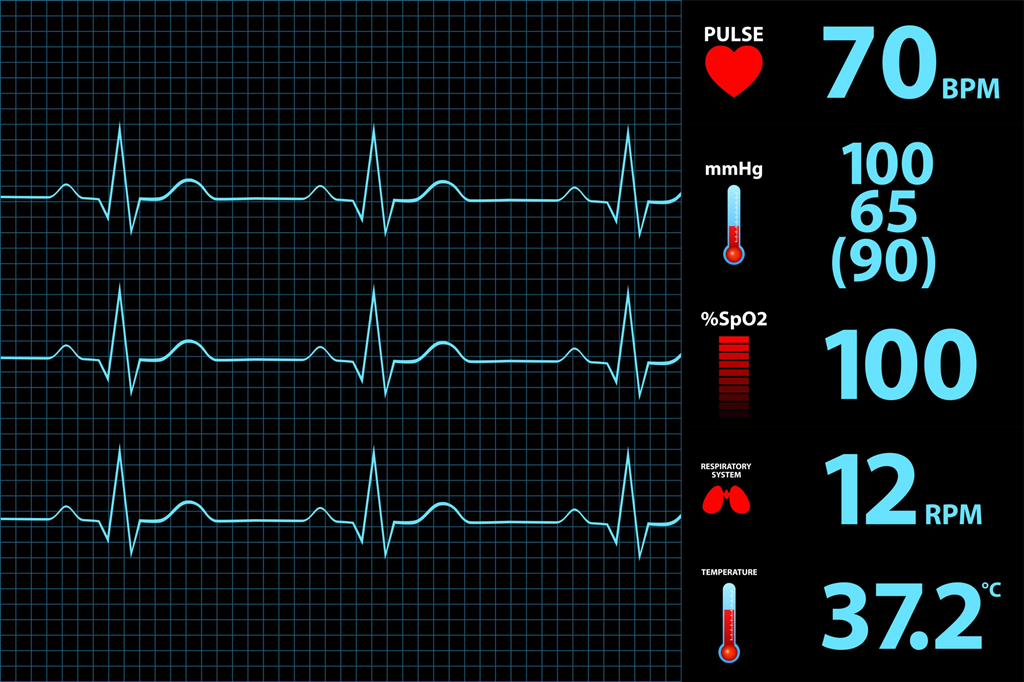Unit 4: Lesson 2: Vital Signs
Lesson 2: Vital Signs

Lesson 2: Vital Signs
Health science professionals who work directly with patients will often need to assess the health and well-being of those patients. One of the basic ways that health science professionals assess a person is through checking their vital signs. Vital signs are physiological statistics that are taken to assess and examine basic body functions. These vital signs include heart beat, blood pressure, temperature, and breathing rate. Vital signs can be measured within healthcare settings such as hospitals or outside of healthcare settings, such as in a person's home.
To measure vital signs, health science professionals and others use several common items. These include a thermometer, a blood pressure meter (or sphygmomanometer), and a watch. Other devices may be used, but vital signs generally can be taken with just these three items. When taking these measurements, health science professionals have to keep in mind that normal measurements in each of these areas can differ depending on factors such as age, sex, weight, exercise condition, and so on. How are vital signs taken and what do they tell us?
Heart Rate
One of the vital signs is your heart rate. Heart rate is simply the number of heart beats within a given period of time. Generally, heart rate is measured in beats per minute. Health science professionals measure heart rate by finding a person's pulse or the arterial palpitation of the heart that occurs as blood is pushed from the heart into the blood vessels of the body. The pulse can be found at any point where the heart's beating is transmitted to the surface of the skin, such as the wrist, inside of the elbow, the neck, and the chest.
Evaluating pulse
When taking the heart rate at one of these points, the index and middle finger are placed at the pulse point and the number of pulsations is counted for a particular period of time. It is important that the thumb not be used to measure heart rate since it is a pulse point as well; it would be difficult to separate which pulse is coming from the area being measured. Health science professionals may also use an electrocardiograph (ECG or EKG) to measure heart rate. This piece of equipment may be used within hospital settings or by EMTs to continuously measure heart rate.
A person's normal heart rate can vary, depending on activity, age, and so on. Resting heart rate is a person's heart rate when they are lying down but not engaged in any activities or sleeping. Most adults have a resting heart rate of between 60 and 90 beats per minute. Athletes may have lower resting heart rates than average adults, and children often have higher resting heart rates than adults. Heart rates that fall above or below the norm can signal a problem. Higher resting heart rates have been linked to cardiovascular risk. Pulses that are difficult to find or feel may indicate blockages in the arteries. Abnormal heart rates can indicate a number of medical issues and by knowing the heart rate, health science professionals have an important piece of information about whether a person is healthy or may be experiencing a health problem.
Blood Pressure
Another vital sign is blood pressure. Blood pressure refers to the amount of pressure placed on blood vessel walls by circulating blood. With each heartbeat, there is both a minimum and a maximum blood pressure. Generally, blood pressure drops to its minimum as blood moves from the heart through the arteries to the capillaries and then back to the heart through the body's veins. When we see a blood pressure reading, it is generally represented by two numbers: the systolic and diastolic measurements. Systolic blood pressure is the maximum blood pressure and diastolic blood pressure is the minimum blood pressure. The numbers are represented with the systolic blood pressure over the diastolic blood pressure, such as 140/90. Blood pressure can help detect issues in blood circulation, including too much pressure on the arterial walls, hemorrhaging or other blood loss, and other health disorders.
Measuring Blood Pressure
Blood pressure is measured with a sphygmomanometer. This uses an inflatable cuff that restricts the flow of blood to the arm and a manometer, which measures the pressure. This device is placed on the upper arm, at about the same height as the heart. In some cases, one arm can have a higher pressure reading than the person's other arm. Health science professionals need to record the readings in order to note the difference. After that, the arm with the highest pressure reading should be the one used for the measurement. In addition, blood pressure can fluctuate over the course of a day and in response to factors such as stress, medications, and exercise. It has also been noted that about 25% of individuals have a higher blood pressure at the doctor's office (or other healthcare setting) than they do at home or in a non-healthcare setting. This is generally due to anxiety or stress, but healthcare professionals should take this into account as medications to lower blood pressure may not be needed by everyone who presents with higher blood pressure at the doctor's office.
When using the sphygmomanometer, a health science professional such as a nurse inflates the cuff around the patient's arm. The nurse will listen to the arm with a stethoscope until the brachial artery is blocked. At this point, the nurse slowly releases the pressure from the cuff. A 'whooshing' sound is heard through the stethoscope when blood begins to flow through the artery. The pressure at which the sound is first heard is the systolic pressure. The pressure at which the 'whooshing' sound ends is the diastolic pressure. Typically, 120/80 is considered normal blood pressure while 140/90 or higher is considered high blood pressure.
